Fruit Tree Pruning Calendar
 It’s the time of year when many are looking for a fruit tree pruning calendar. Providing a pruning calendar specific to the type of tree one might have in their yard is always helpful!
It’s the time of year when many are looking for a fruit tree pruning calendar. Providing a pruning calendar specific to the type of tree one might have in their yard is always helpful!
Knowing some basics of how and why can help to provide a better understanding of the when. I have gathered together a list of common fruit trees and a calendar for when the best time to prune them lands in the year.
Table of Contents
Winter Fruit Tree Pruning
 The simplest way to do a this is to follow the standard calendar, so the frame of reference for most of us is the same. Every gardener should begin the year by performing their January Gardening Tasks, however those with fruit trees should also begin pruning as well.
The simplest way to do a this is to follow the standard calendar, so the frame of reference for most of us is the same. Every gardener should begin the year by performing their January Gardening Tasks, however those with fruit trees should also begin pruning as well.
Starting with winter, we find that there’s a lot of pruning fruit trees to be done; depending on what kind of fruit trees you have.
Deciduous Trees
The dormant stage of most deciduous trees (ones that lose their leaves during autumn) is where the tree pulls the energy away from the leaves, and down into the roots. The only real growth that occurs during the winter- slow though it is- is down in the roots.
That stored energy is kept and held ready to burst forth in the spring with new buds, flowers and leaves in the spring.
Due to this pending energy surge, late winter (after the coldest part of winter is past) pruning means there will be a shorter period for the tree to have to deal with the pruning wound. The surge in early spring energy will assist in the rapid healing, and more focused growth where it is wanted. For eligible candidates, pruning in the winter encourages vigorous growth.
Fruit Trees
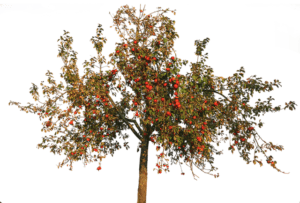 Fruit trees that are most often good with an annual pruning are apple and pear trees. Sometimes pear trees can become biennial fruiters where they fruit better every second season.
Fruit trees that are most often good with an annual pruning are apple and pear trees. Sometimes pear trees can become biennial fruiters where they fruit better every second season.
Both types of fruit tree can bear on spurs and less vigorous shoots, so make sure to take that into account when selecting branches for pruning. Typically, pruning approximately 20% of last year’s growth is acceptable.
 Olive, fig, and citrus trees should be pruned after the harvest finishes. This is usually early to mid winter for olive and fig, and mid to late winter for citrus. (Make sure the danger of frost has passed for citrus.
Olive, fig, and citrus trees should be pruned after the harvest finishes. This is usually early to mid winter for olive and fig, and mid to late winter for citrus. (Make sure the danger of frost has passed for citrus.
For these fruit trees, annual pruning might not be necessary and should only be pruned as needed. (Generally not more than 20%, and bear on spurs- so make sure to take note of what type of branch being pruned.)
Citrus Trees
For citrus trees, simply make sure to skirt prune (cutting back the low-lying branches) about 18 inches off the ground. This prevents ground pests from having easy access to the boughs as well as preventing disease
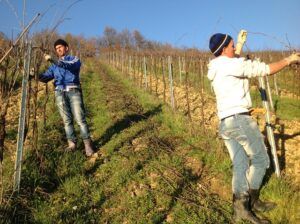 For grapes and kiwifruit prune in the winter and back to between 3 and 5 buds. Tie back any long or new branches to train the plants into the desired shape.
For grapes and kiwifruit prune in the winter and back to between 3 and 5 buds. Tie back any long or new branches to train the plants into the desired shape.
Because these fruit will bear on last years’ shoot growth and are known to grow quite a bit, it’s a good idea to remove at least 50% of last years’ growth.
Spring Fruit Tree Pruning
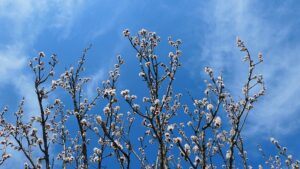 There are a few reasons one might want to wait until spring to do fruit tree pruning. Some fruit trees suffer damage to branches that won’t recover after winter. In order to ensure healthy branches are left and damaged ones are removed, waiting is key.
There are a few reasons one might want to wait until spring to do fruit tree pruning. Some fruit trees suffer damage to branches that won’t recover after winter. In order to ensure healthy branches are left and damaged ones are removed, waiting is key.
When spring arrives and the branches start to show buds, that will be a great indicator of what- if any- winter damage has been done. This provides an easy decision as to which limbs need to be cut back, and how far. This will not encourage growth like winter pruning because a lot of the energy that was saved up in the roots all winter has already been expended on budding and leafing as the emergence from dormancy already occurred.
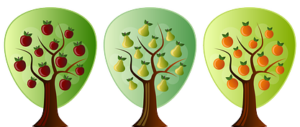 Spring pruning for fruit trees is a good method to make the trees themselves more compact. If space is an issue, or if a higher density/yield for harvest is desired, spring pruning is a good way to manage the shape of the tree.
Spring pruning for fruit trees is a good method to make the trees themselves more compact. If space is an issue, or if a higher density/yield for harvest is desired, spring pruning is a good way to manage the shape of the tree.
Tender Fruit Trees
 For what is known as “tender fruit trees” (peach, apricot, and cherry to name a few) in temperate climates with mild winters, spring can be a good time to prune. Chilean guavas are often pruned in early spring as well.
For what is known as “tender fruit trees” (peach, apricot, and cherry to name a few) in temperate climates with mild winters, spring can be a good time to prune. Chilean guavas are often pruned in early spring as well.
These trees can be more susceptible to winter damage, but are often known to produce better yields and better tasting fruit when exposed to some cold temperatures. Peach and nectarines are both known to bear on the last year’s shoot growth and are known to often grow a lot. Cutting back at least 50% of last year’s growth is often recommended.
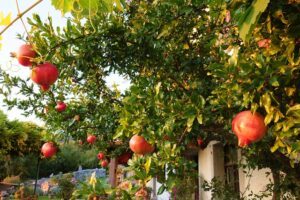 There are some tender fruit trees that are often only grown in climates free from frost, like pineapple, mango, pomegranate, papaya and citrus trees. (For any citrus that have later harvests or when late frosts are common, waiting until spring is best.)
There are some tender fruit trees that are often only grown in climates free from frost, like pineapple, mango, pomegranate, papaya and citrus trees. (For any citrus that have later harvests or when late frosts are common, waiting until spring is best.)
Summer Fruit Tree Pruning
 When spring turns into summer, pruning takes on a different role. Sometimes there might be a need to slow growth. This is where summer pruning comes in. When fruit trees get too tall, harvesting becomes much harder without the proper equipment.
When spring turns into summer, pruning takes on a different role. Sometimes there might be a need to slow growth. This is where summer pruning comes in. When fruit trees get too tall, harvesting becomes much harder without the proper equipment.
In order to maintain reasonable height and easier harvesting, summer pruning is often used to curtail the excessive upwards growth of some types of fruit trees. For example, some cherry trees can reach a height upwards of 2-3 stories! There are other reasons for summer pruning, including removing any crisscrossed branches or limbs that are rubbing against one another.
 Some types of fruit known as “stone fruit” trees- fruit that have large pits or seeds (aka “stones”) in the center of the fruit- that should be allowed to fully fruit. Nectarines, peaches and plums are examples of stone fruits.
Some types of fruit known as “stone fruit” trees- fruit that have large pits or seeds (aka “stones”) in the center of the fruit- that should be allowed to fully fruit. Nectarines, peaches and plums are examples of stone fruits.
Once the tree has completed the fruiting, often in late summer, pruning is recommended, if needed. Almond trees and blueberry bushes (although not always needed) are also generally pruned in late summer after fruiting has finished.
Avoid Autumn Fruit Tree Pruning
 In general, pruning in autumn is not a good idea. Due to the fact that the trees are starting to go into their dormant phase, if pruning is done incorrectly or too late in the season, the tree might not have enough energy to heal the wounds properly- if at all.
In general, pruning in autumn is not a good idea. Due to the fact that the trees are starting to go into their dormant phase, if pruning is done incorrectly or too late in the season, the tree might not have enough energy to heal the wounds properly- if at all.
General Fruit Tree Pruning Guidelines
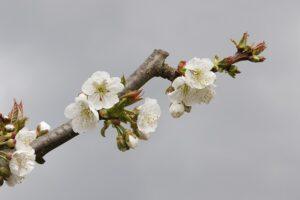 When pruning, make sure to not cut right at the bud, but leave 1/4 inch of stem past the bud.
When pruning, make sure to not cut right at the bud, but leave 1/4 inch of stem past the bud.
Sharp pruners are always essential because the cleaner the cut, the less damage the tree has to repair, and the more quickly the tree heals.
New growth will occur where the cut is made. The direction of the branch to prune matters as well.
Branches
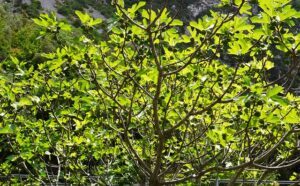 Vertical branches are more scaffolding branches, that do more vegetative leafy growth to focus on energy production for the tree.
Vertical branches are more scaffolding branches, that do more vegetative leafy growth to focus on energy production for the tree.
Horizontal branches are the lateral, fruit bearing ones. Distinguishing between the two can be difficult at first, but is an important step in proper pruning. One of the best ways to determine the structure of the tree is by viewing it in late winter, before foliage has made it more difficult to see branches and determine their necessity.
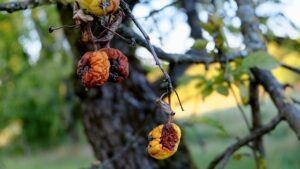 Make sure to also do an assessment for damage and disease and remove any effected branches, to keep the tree as healthy as possible. These branches need to be removed and disposed of properly, no matter if they are scaffolding or lateral.
Make sure to also do an assessment for damage and disease and remove any effected branches, to keep the tree as healthy as possible. These branches need to be removed and disposed of properly, no matter if they are scaffolding or lateral.
When selecting branches to prune, it is important to know what type of branch to cut and why. There are 3 types of branches: scaffolding and lateral branches and spurs. Lateral branches produce flower buds and are sometimes also encompassed by leaf buds.
Buds
Flower and leaf buds look different and knowing which is which keeps the inadvertent pruning of the upcoming harvest from occurring. Leaf buds are typically flat and pointed, while fuzzy, plump buds produce flowers- which turn into fruit. Without pruning, fruit will only form at the ends of branches instead of lower or inward branches; making harvest easier.
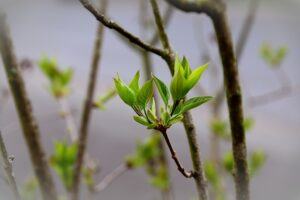
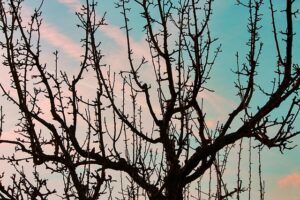 The flowering buds like sunlight and good air circulation, which means strategically pruning. Spurs are short, fat branches that put out flower buds, and therefore, bear fruit.
The flowering buds like sunlight and good air circulation, which means strategically pruning. Spurs are short, fat branches that put out flower buds, and therefore, bear fruit.
Apple trees have spurs that form in clusters, where peach trees have spurs along lateral branches. Spurs are about 6 inches long, and identifying where the spurs are help you know what to leave and what to keep for potentially years’ at a time. Apple, cherry, plum and pear tree spurs can last up to 10 years!
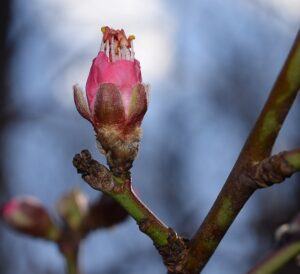 There is also something that is known as first- and second-year wood. This determines if the tree will bear fruit in its first or second year. On peach, nectarine and fig trees are second-year wood trees. In nectarines and peaches, second-year wood has a reddish-green coloring, and is easier to distinguish.
There is also something that is known as first- and second-year wood. This determines if the tree will bear fruit in its first or second year. On peach, nectarine and fig trees are second-year wood trees. In nectarines and peaches, second-year wood has a reddish-green coloring, and is easier to distinguish.
The spurs can be hard to pick out because they are so short, but make sure to take note by looking at the buds. If they have flower buds instead of leaf buds, do not prune or the harvest will be effected. There aren’t very many fruit bearing first-year wood trees.
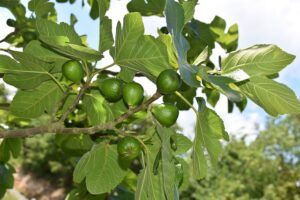 First-year wood trees like figs will bear some fruit on first-year branches, but (with figs in particular), there will be a second crop on second-year wood during autumn usually.
First-year wood trees like figs will bear some fruit on first-year branches, but (with figs in particular), there will be a second crop on second-year wood during autumn usually.
Walnut trees are also first-year bearers, while almonds are more like the apple trees in that they have spurs that produce year after year.
Fruit Tree Pruning Calendar Conclusion
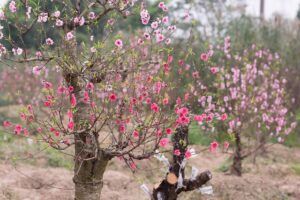 Understanding the basics of how and why to prune help to make a better plan when it comes to caring for your fruit trees year round.
Understanding the basics of how and why to prune help to make a better plan when it comes to caring for your fruit trees year round.
There are always going to be environmental factors and different circumstances that need to be taken into account, but armed with these tips and tricks, putting together your very own pruning schedule will be easier than ever! No matter if it’s a local orchard for a farmer’s market, decorative non-harvest pruning needs, or your own backyard, this fruit tree pruning calendar has got you covered!
Do you have any recommendations or feedback to add to the discussion? Please feel free to comment below! I answer every comment. You can also email me at Randi@FairyCircleGarden.com.
Did you like this article? Please share it on your favorite social media page! For more great content please check out our other articles and follow our social media pages on Facebook, Instagram, Pinterest and more!
Gratefully,
Randi
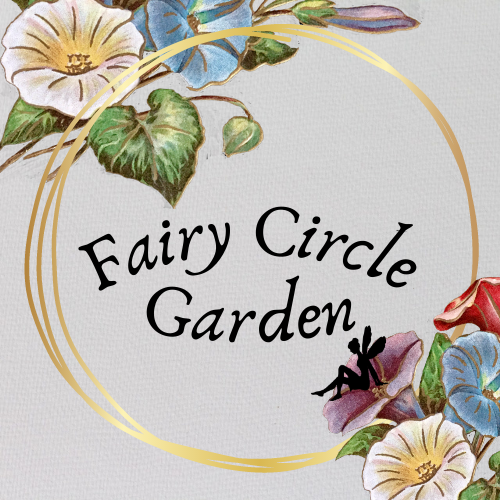

This topic came in handy for me, even though it is based on outside gardening. I do have some experience with pruning but in a more tropical world.
I have many plants indoors and due to winter temperature, such as coming from my sky roof I covered that area in which that specific plant resigned, I notice many of the leaves are falling off more than usual when there was no covering, so I will have to prune it for it to be healthy again.
Very helpful topic.
Oh no! Pruning will sometimes help with unexpected leaf drop. Forcing the tree to refocus the flagging energy it was sending to the branches in question can help bolster the energy production to the rest of the tree. Make sure to consult the pruning guides for whichever specific type of tree you have to make sure the timing and form of the pruning is done correctly.
It is necessary to take care of the trees in the garden throughout the year. Pruning trees is of no small importance because it depends on how correctly formed the crown of the plant. I have been learning recently that in order for the tree to have an even distribution of strength, as well as nutrition, it must not only be timely fed and protected from harmful insects and various diseases but also systematically and correctly cut in the fall.
That is very true that feeding, protecting from harmful insects and diseases as well as correctly pruning at the correct time is all part of a healthy tree. Different trees require pruning at different times, so make sure to check the variety of tree and its needs before making any cuts! Good luck!